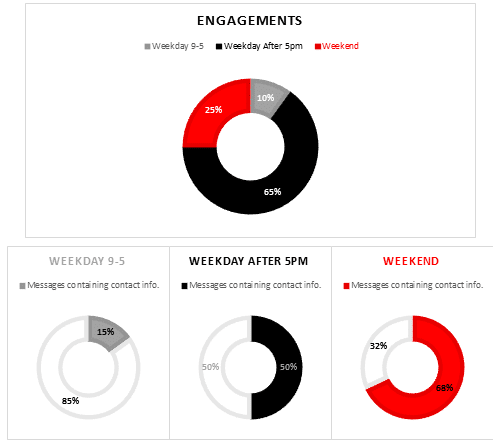Executive Summary:
A large portion of the United States population works a weekday 9-5 job. This leaves weekday evenings and weekends for running errands, making appointments and handling other personal matters. For this reason, 24/7 monitoring of social media channels is essential in order to engage with leads as soon as they come in.
In this case study, Today’s Business analyzes the Facebook pages of our medical clients, specifically those in the Midwest portion of the United States. We specifically took note of the exact times that these clients were receiving leads in the form of private messages, wall posts and comments. The results were as follows:

Weekday 9-5
- 10% of messages come at this time
- 15% of these messages contain contact info.
Weekday After 5pm
- 65% of messages come at this time
- 50% of these messages contain contact info.
Weekend
- 25% of messages come at this time
- 68% of these messages contain contact info.
Overall
- 28% of messages contained contact info.
There is reason behind these numbers: While many browse social media platforms at work, that is not the time or place to think about and/or make decisions on medical or other sensitive matters. For medical clients especially, it takes more than just a like for users to engage. Patients need to do their own research on their own time, before they are ready to reach out.
With a whopping 90% of leads coming in outside of the weekday 9-5 range, medical practices cannot afford to rely on simply engaging with patients during that timeframe, as they will be losing out of majority of business.
In addition to these statistics, the high-time of receiving leads is between 8-9pm. According to a study by Lithium Technologies, 53% of who engage with a brand on expect a response within 1 hour, regardless of the time at which they inquired. Waiting until 9am the next work day to engage with this user presents the risk of losing this lead for the client.
Whether or not the user provides their contact information in the message is vital in that the lead is now considered a “high quality lead”. The user has provided a way for the client to reach them, continuing the conversation outside of social media.
This shows promise of turning the lead into a patient.




.svg)